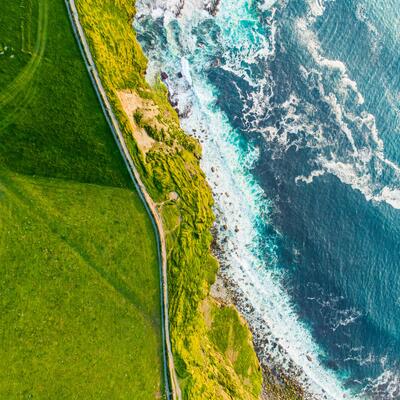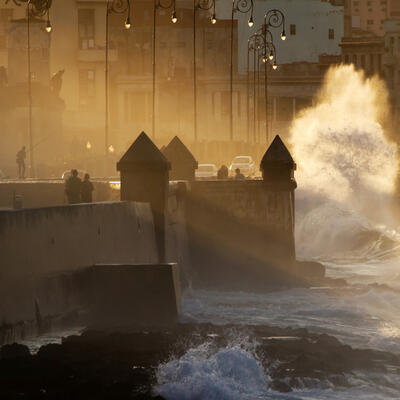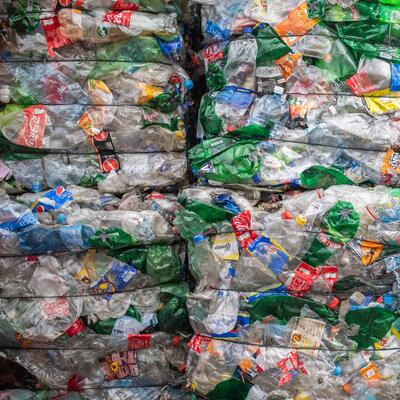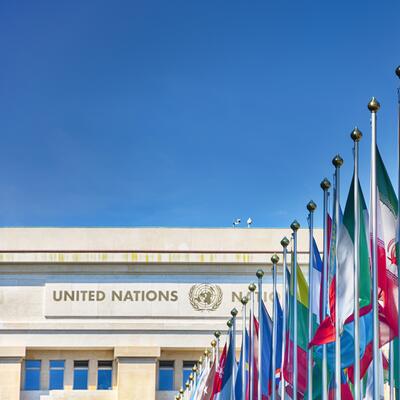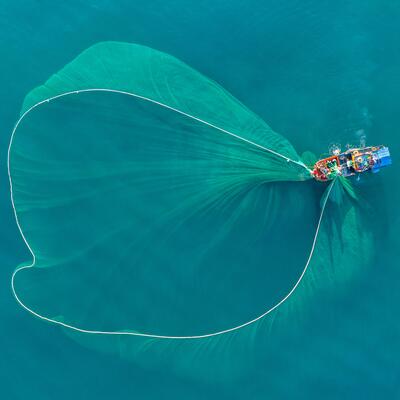
Net Gains: Saving Seafood Before It’s Too Late
Guests
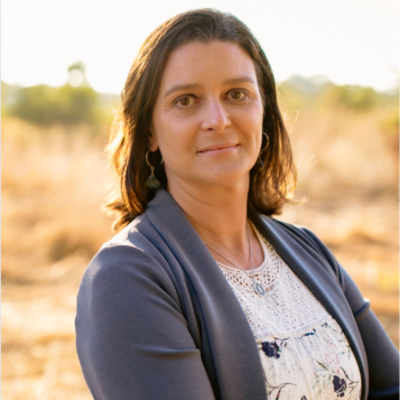
Tessa M. Hill
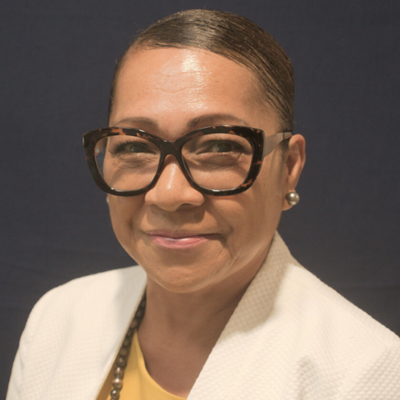
Mona Ainu’u
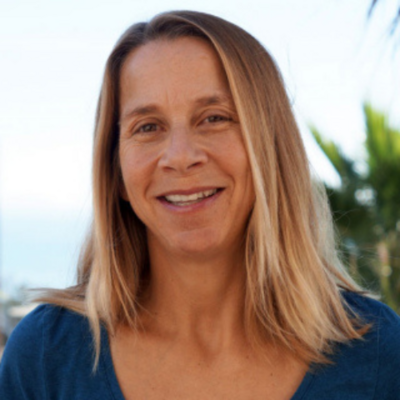
Jenn Caselle
Summary
More than three billion people rely on seafood as a primary source of animal protein. Yet due to the effects of the climate crisis, water is warming, habitats are changing, and fish are moving. What does that mean for the future of marine life and the communities that rely on them for food?
“The ocean absorbs about 30% of that carbon dioxide that we put into the atmosphere through our human activities. And so as the ocean absorbs that, the chemistry of the ocean fundamentally changes,” says Tessa Hill, professor at the University of California, Davis and author of “At Every Depth: Our Growing Knowledge of the Changing Oceans.”
Hill explains that three different changes are happening concurrently: First, the oceans are warming, which – on its own – stresses many species. Second, warmer oceans don’t hold as much oxygen, creating dead zones. And third, the carbon dioxide absorbed from the atmosphere by the oceans makes the water more acidic. This makes it more difficult for organisms to build and maintain their shells – which in turn can lead to the collapse of whole ecosystems.As the ocean environment changes, the creatures living in it need to move or adapt.
“If you're an invertebrate, like a mussel or a clam or an oyster and you're attached, you're kind of stuck,” says Hill. Some fish are moving to more moderate areas of the ocean. But changes are happening fast, at a pace we’ve never seen before. Hill says the pace is so fast that “it actually limits our ability to learn lessons from the past evolutionary record.”
Fish aren’t the only animals that need to adapt to the changing ocean conditions. “Those of us who are reliant on those fisheries are also required to adapt. And that may mean, fishing in new places,” says Hill. That might mean places farther away, which can make the process more expensive.
“We need all of the eyes on the water: the fishing community, the coastal community, tribes, scientists, everybody,” says Hill.
Off the coast of New England, warming oceans are bringing in new fish species, and possible new opportunities for the fishing industry. But the changes are happening at such a fast pace, regulators and even fishermen themselves, are having trouble keeping up.
“New England's Fisheries generate more than $20 billion in sales each year and employ more than a quarter million people,” says Barbara Moran, reporter for WBUR. “Fishermen need more tools to adapt to climate change. Things like more flexible permits, more complete science, and the ability to land the new fish that are coming in.”
In the U.S., tuna is in the top three most consumed seafood items. And globally it’s an integral part of some island communities. Mona Ainu'u is the Minister of Fisheries for the island nation of Niue. She says, “Tuna is food security for us. It's absolutely an important part of our diet and our livelihood as ocean people.” But lately the waters surrounding Niue have not been as plentiful with tuna as they used to be, Ainu’u says, “We used to have fish all the time. Unfortunately in the last couple years, we are seeing that men go out, and come back with no catch.”
The people of Niue are taking action to try and rebuild the tuna population. The 1982 United Nations Convention on the Law of the Sea created Exclusive Economic Zones, or EEZs. Niue designated their entire EEZ a marine park, and 40% of it is a marine protected area where fishing, seabed mining, and mineral and oil exploration are prohibited. Ainu’u says, “At the end of the day, you have to make a commitment for the betterment of everyone. It is a challenge for us, but it's necessary because for us to continue to enjoy what we have.”
Similarly, in California, overfishing in the 1980s and 90s devastated the rockfish population. But now Marine Protected Areas are helping to bring them back.
When fish aren’t being caught by people, their population grows, and larger fish become more common. “Larger fish produce disproportionately more larvae or babies, which then can spill over from the marine protected areas to the outside areas and grow up and be fished,” says Jenn Caselle, Research Biologist at the Marine Science Institute at UC Santa Barbara.
“We want sustainable fisheries for the future. We want sustainable fishing jobs for fishing families. We also want biodiversity and charismatic megafauna. We want unpolluted waters. We all want the same thing, so as long as everyone keeps showing up, as long as we can still talk to each other, that's really what gives me hope,” says Caselle.
Resources From This Episode (4)
Full Transcript
Note: Transcripts are generated using a combination of automated software and human transcribers and may contain errors. Please check the actual audio before quoting it.
Ariana Brocious: I’m Ariana Brocious.
Kousha Navidar: I’m Kousha Navidar
Ariana Brocious: And this is Climate One.
[music change]
Kousha Navidar: Ariana, I’ve got a great idea for an episode. Hear me out. Fish.
Ariana Brocious: What about them?
Kousha Navidar: Ok so, I eat a lot of seafood. One of my first memories with my now-wife was when we went to New Orleans the first couple weeks we started dating and I ate an oyster the size of my hand.
Ariana Brocious: Wait, don’t you usually eat oysters without really chewing them? How did you choke that down?
Kousha Navidar: I chewed. And I still enjoyed it. And maybe my love of seafood is a bit more extreme than a lot of other people in the U.S., but it’s not that different from much of the world. More than three billion of us rely on seafood as a significant source of animal protein.
Ariana Brocious: Yeah, okay, that’s a third of humanity. And that could be challenging because we also know that the oceans are warming. Habitats are changing. And fish are moving, trying to adapt.
Kousha Navidar: Exactly. So I started asking, how are the most popular fish we eat, and the communities that have relied on them for centuries, doing? And so I started looking into this. And what I dug up – or reeled in?
Ariana Brocious: I’ll allow that pun.
Kousha Navidar: Ok so what I found were a bunch of stories – many of them success stories, about fish, and about the people protecting them. So, what do you think, is this worth an episode?
Ariana Brocious: Yeah, I’m hooked!
Kousha Navidar: Excellent. And that’s what this episode is about, Then on today’s show, we’ll go around the world, from the rocky shores of New England to the picturesque island of Niue, to investigate how three popular fish are doing. We’ll also meet people who preserve and regrow populations in different ways.
Ariana Brocious: First, let’s get a sense of what’s going on in the oceans. Tessa Hill is a professor at the University of California, Davis and author of At Every Depth: Our Growing Knowledge of the Changing Oceans.
Tessa Hill: Many things are changing all at once in the ocean, largely due to human impacts. Heating of the ocean due to global climate change. We're also seeing a decline in the amount of oxygen in the ocean. So as we get those ocean waters heated up, the oxygen actually kind of escapes the water, because the water can hold less oxygen in those heated conditions. and then there's a chemical change happening in the ocean, which is what we call ocean acidification, and that's simply because the ocean absorbs about 30% of that carbon dioxide that we put into the atmosphere through our human activities. So as the ocean absorbs that, the chemistry of the ocean fundamentally changes. And so if you're an organism in the ocean, you're seeing all three of those things change at once.
Ariana Brocious: So let's speak specifically to fish. Are those stressors necessarily bad for fish?
Tessa Hill: They aren't necessarily bad, but what we generally see for, uh, fish and invertebrates is that they have sort of a tolerance zone in particular for temperature and oxygen. And as those things change out of their tolerance zone, if you're a fish and you can move, you may attempt to move. Iif you're an invertebrate, like, um, a crab, you might move along the bottom. If you're an invertebrate, like a mussel or a clam or an oyster and you're attached, you're kind of stuck.
Ariana Brocious: I wanna talk about the pace of change because obviously we know that species adapt. Are these conditions things that fish can evolve or adapt to?
Tessa Hill: In terms of the pace, in a nutshell, what we see is that there's really no equivalent in earth history to what is happening today. So the rate of change is so fast today that it actually limits our ability to learn lessons from the, you know, the past evolutionary record because we can't find time intervals in, you know, earth's history and evolutionary history that match today's rate of change. And then I'll just sort of add a layer on the fact that many different things are changing at once And so for a lot of organisms along the coast, they're seeing not just one stressor, but maybe two stressors at the same time, you know, reduced oxygenation or a change in pH or both. And so we see organisms both contending with multiple challenges at once. Multiple changing parameters at once, but also sometimes they're getting hit in sequence by stressful conditions.
Ariana Brocious: So I wanna talk a little about the lab you run and the work you all do there. Can you, can you describe it and give us a sense of some of the research that you, that you're pursuing?
Tessa Hill: One of the ways that we think about climate change in the coast is reconstructing past conditions, So thinking about all of the different data that we can collect on ocean acidification and also oxygenation of the ocean as well as temperature and mapping those trends, looking at where some of those stressful conditions are showing up and where maybe they aren't. I've collaborated quite a bit with biologists and ecologists who think about all of these climate change impacts on the animals themselves. And so we've done a lot of work together where we build an apparatus in the lab that sort of operates like a time machine. We have done some work where we raised oysters in these conditions, And then in a tank next to that, we actually kept temperature the same, but we changed the ocean acidification parameter, so the pH of the water. And um, so we did that. Sort of estimating 2050. And then the tank next door to that, we did a version that estimated sort of 2100 conditions. We're raising, um, baby oysters. So these are, um, these are, these, these oysters are at the stage of their life where they're actually floating around in the water. And so they're sort of swimming in the water. And they will eventually become kind of teenager oysters. And at that point they actually settle down to the bottom of the tank and they attempt to like attach to something on the bottom. And in the wild that's what they do. They float around in the water and then when they're ready and they're approaching teenager hood as an oyster, uh, they, um, settle down and they often find other oyster shells to settle on and that's how they find each other. and what we see in general is that they grew smaller and thinner shells under those acidified conditions, and we were able to show that, you know, having a thinner shell means that it's easier, for example, for a predator to attack you. And so that change in chemical conditions in the ocean has a consequence for those oysters.
Ariana Brocious: What are some of the trends that you're seeing with the fish that people commonly eat, like cod, tuna, salmon around the world?
Tessa Hill: Yeah, so I think in general, probably the most powerful and interesting trend that we're seeing is that those fish are changing the location where they're living. And so we're seeing, you know, in the Northern Hemisphere, um. As, as water temperatures warm, what we see is sort of a northward march of marine species. And so species that you know, um, have been fished along the northeast coast of the United States are starting to migrate northward into places that they were not previously located. We're seeing the same thing on the west. Coast of the United States, And fishing communities who are, um, you know, relying on those species as the, the, you know, the subject of their, their catch and contributing to our coastal economies are having to adapt and move with them. And I'll just add in that in the United States, interestingly enough, we, uh, import most of the fish and seafood that we eat is brought in from other countries. And so, ways that we can support our own local fishermen, um, you know, requires that we support and bolster that part of our economy and actually consume fish that's been caught within the United States, but also it means, you know, supporting people in this, this climate adaptation path that we're on.
Ariana Brocious: Would you say there are particular species that are emerging as winners or losers in this, in changing environment, ocean environment.
Tessa Hill: I will say with invertebrates, I think there are winners and losers. Um, and a lot of it has to do whether, uh, with whether or not they're sort of tolerant of a wide range of conditions and or can adapt rapidly to changing conditions. And so I think we do. I guess the good thing is that we see a lot of variability in how organisms in the ocean respond to changing environmental conditions. And that's a good thing because anytime there's sort of a variety of responses that tells you that there's a little bit of a window. There's a potential for adaptation and there's a potential for species that are gonna be robust to these changing conditions. And I guess I would say we also have the ability to to help in those winners and losers. And so I think there's a couple ways that we help. One is that we fundamentally have to address the challenge of climate change. We have to address the emissions of carbon dioxide to the atmosphere. That is the underlying challenge, you know, that we're addressing through this whole conversation. And so, you know, the first and best thing we can do is think about how we're gonna address that problem. But the other thing we can do is sort of arm organisms with some, some tools, um, to adapt and to be safe and resilient in these changing times. And one of the ways we do that is through conserving areas of the ocean, um, that can be sort of refuges as, as the world changes quite a lot.
Ariana Brocious: I'm imagining an oyster holding like a pickaxe and a hammer right now. Different tools.
Tessa Hill: I need tools.
Ariana Brocious: yeah. So let's expand on that because I think this is another component that you're really interested in. we know there are some things we can do that can help address climate change, but also have these environmental benefits, and so sea grass growing seagrasses is one of those. Can you, can you talk about why that can be so beneficial?
Tessa Hill: It's amazing sea grass. I, I think about them a lot like sort of the forests that we think about on land. So when we think about forests on land, we think about them, um, absorbing carbon dioxide through photosynthesis. And so there's CO2 actually being pulled outta the atmosphere into the trees itself. And so the trees are really important, but also the trees create these conditions where layers of soils build up below the trees, and so you get these sort of layers of carbon being stored below the trees. And so we think about forests on land as being real carbon storage powerhouses, and it turns out that seagrasses in the ocean are doing the same thing and to the same degree. So they're like the same amount of powerhouse of carbon storage. So they are using photosynthesis, and so they're removing carbon dioxide from the water. But they also are trapping layers of sediment or soils below the sea, grass in the roots. And they trap all sorts of material that sort of floats through the grass, um, gets trapped and deposited in those layers of sediment. And that material includes a lot of carbon. That is then stored there for hundreds, if not thousands of years. And so what we've learned through our research is that simply by conserving those areas and protecting those seagrass meadows, we actually are, um, trapping and storing carbon, you know, from the atmosphere, um, into the ocean.
Ariana Brocious: And they have cascading benefits, right? Because they also serve as habitat for all kinds of coastal species.
Tessa Hill: Yes. So when we talk about restoring and conserving sea grasses, we just talk about this as a win-win-win. So when you have healthy and um, protected sea grass meadows, they do stabilize the shorelines. So when we think about, um, sea level rise and storm surges, they're actually sort of helping all those layers of sediment and mud, you know stay in place. They act to filter the water. So there's actually, um, evidence showing that pathogens and, you know, other pollutants that might be moving through seawater are actually, you know, trapped and filtered out by those seagrass meadows. And they provide an amazing habitat for organisms including the larval and juvenile, um, versions of a lot of invertebrates and fish. So actually rockfish are, they're, they're like baby versions are found, um, in Seagrass Meadows and same with Dungeness Crab. So they really, they like are ba we talk about them as a nursery ground. So they're like literally the. They're the nursery school and the preschool for a lot of the baby organisms that we, that grow up and then we like to eat them. And so, you know, when we talk about conserving Seagrass Meadows, you know, I'm always saying, well, we can do this for the purpose of, of carbon storage. But even if it wasn't, even if they weren't storing carbon, this is a habitat we want to save and protect.
Ariana Brocious: Tessa Hill is an oceanographer and professor in the Earth and Planetary Sciences Department at the University of California Davis, where she teaches and researches oceanography and climate change. Tessa, thank you so much for joining us on Climate One.
Tessa Hill: Thank you so much for the opportunity. It was a great conversation.
Kousha Navidar: Coming up, on the Pacific island of Niue, tuna drives the economy and is integral to the culture. But the once plentiful waters are facing serious challenges.
Mona Ainu'u: Over the years, there's been a lot of Illegal fishing. There's been a lot of natural disasters that have impacted the ocean.
Kousha Navidar: We’ll hear how one political leader is approaching sustainable fishing when Climate One continues.
Ariana Brocious: Help others find our show by leaving us a review or rating. Thanks for your support!
This is Climate One. I’m Ariana Brocious.
Off the coast of New England, the oceans are warming due to our increased emissions of greenhouse gasses. That’s bringing in new species of fish, and possible new opportunities for the fishing industry. But the changes are happening at such a fast pace, regulators and even fishermen are having trouble keeping up. Columbia University’s Duy Linh Tu contributed to the reporting. WBUR reporter Barbara Moran takes it from here. This story was produced as part of the Pulitzer Center's StoryReach U.S. Fellowship.
[WBUR REPORT]
Barbara Moran: The deck of the fishing boat Paladin is flopping with flounder. The boat's about 20 miles off the coast of Nantucket. Fisherman. Bill Amaru casts a line off the side, reels in a fish and shows it off along with some self-deprecating dad humor.
Bill Amaru :That's a nice fish.
Barbara Moran: Yeah. How big is that?
Bill Amaru: Uh, I'd say it'll just be a borderline large, probably two pounds. Just even a blind squirrel finds a nut now and then Amaru has worked as a
Barbara Moran: commercial fisherman for more than 50 years. And he sees the ocean changing. The water is several degrees warmer than when he started out, so it's more welcoming to warm water, fish.
Bill Amaru: Nothing is weird anymore out here. Tropical is getting to be fairly common, but I think what we're losing is way, way in excess of what we're gaining.
Barbara Moran: What scientists say New England is losing are iconic species like cod and lobster. They've shifted north or moved to deeper parts of the ocean in search of colder water.
John Hare: What surprised me the most was the magnitude of the changes.
Barbara Moran: John Hare is the director of the Northeast Fishery Science Center. He says Higher temperatures are not the only change in New England waters
John Hare: as, uh, carbon dioxide increase in the atmosphere, um, than it dissolves into the ocean, and that makes the ocean more acidic. And there's also changes in ocean circulation and which are becoming more pronounced as climate change continues.
Barbara Moran: Most of these changes are harming New England fisheries. Habitats are changing, invasive pests are arriving, and many valuable fish species are in decline. The impact on fishermen can be devastating.
Meeting: Good morning, everybody. Welcome to our final day of the September New England Fishery Management Council meeting.
Barbara Moran: Complex rules govern the fishing industry. A system of catch limits and quotas determines when, where, and how much people can fish. The regulations are often contentious.
Meeting: First thing on our agenda today is our herring committee report. And…
Barbara Moran: last fall, New England fishermen gathered at a hotel ballroom in Gloucester to learn how much herring they'd be allowed to catch for the next two years. Data collected by government scientists shows the number of herring decreasing, so regulators proposed reducing the catch. By 89%.
Daniel Phil: You crazy. That's decimation on the whole herring fleet.
Barbara Moran: Herring fisherman Daniel Phil told the committee his proposal would jeopardize the industry and he says the numbers are wrong. He says he sees plenty of herring in the water.
Daniel Phil: Youknow, you might be scientists and smash people in the world, but you get out on the water, you're gonna be the dumbest ones out there
Barbara Moran: Later, I spoke with Mary Beth Thule, who works for a fishing company in Maine. Her bosses are planning to mothball their two herring boats this year.
Mary Beth Thule: They will tie those vessels up for 2025. The amount of fish that's allocated is not enough to, um, quite frankly pay your insurance to get away from the dock.
Barbara Moran: Thule has lots of concerns about the industry. She worries about how wind farms could affect fish and fishing grounds, and she shares some concerns about regulators' data. But she says the biggest risk for commercial fishing in New England is climate change, and it's happening so quickly that fishermen, scientists, and regulators can't keep up.
Mary Beth Thule: The pace of change right has been much faster than people had anticipated, and the pace of regulatory change is not fast.
Barbara Moran: In other words, the fish are moving, but many regulations are stuck. Take black sea bass, it's a fish people want to eat, and it's expanding into New England waters. But it's not historically a New England fish. So most of the quotas and permits to catch Black Sea bass are still trapped further south, reserved for fishermen in the Mid-Atlantic.
Kate O'Keefe: What that means for us and not having any management authority over it is that we don't have opportunities to harvest it.
Barbara Moran: Kate O'Keefe is the executive director of the New England Fishery Management Council. She says Fishermen need more tools to adapt to climate change. Things like more flexible permits, more complete science, and the ability to land the new fish that are coming in.
Kate O'Keefe: It's a very high priority for us right now as we see some of our traditional stocks declining or shifting north to Canada. We wanna be able to take opportunities of stocks that are shifting into our waters.
Barbara Moran: The Biden administration invested hundreds of millions of dollars through the inflation reduction Act to help fisheries meet the challenges of climate change. It's unclear how these initiatives will fare under President-elect Donald Trump. Trump has promised to pull back such funding, and he's called global warming a scam. O'Keefe says she's hoping to work with the incoming administration. She says the impacts of climate change are too important to ignore. And time is running out.
Kate O'Keefe: My biggest worry is losing the industry. We can't wait a decade 'cause there won't be New England fishing industries left anymore.
Barbara Moran: That would be a blow to the region. New England's Fisheries generate more than $20 billion in sales each year and employ more than a quarter million people like Bill Amaru. When his boat gets back to the dock. Amaru and his crew load coolers of fish into the bed of a pickup truck. Then take them to be weighed.
Bill Amaru: That adds up to, uh, yeah. 170 pounds.
Barbara Moran: Okay. And is that good?
Bill Amaru: That's better than a poke in the eye with a sharp stick. How? How? How would we put it that way? No, it was okay. It was an alright trip.
Barbara Moran: All joking aside for Amaru, the stakes are personal. His son and grandson are both full-time commercial fishermen. Amaru worries about their future.
Bill Amaru: The more that we disrupt the climate, the more that these things are happening and it's, it's making it very difficult to make a living on the traditional stocks. The fish just are not here anymore like they were back then.
Barbara Moran: The question is whether the industry can adapt to the new fish coming in. Amaru is betting that it can, he just invested in a rare permit and a new set of traps. Designed to catch Black Sea Bass. for 90.9 WBUR. I'm Barbara Moran.
Kousha Navidar: This story was produced as part of the Pulitzer Center's StoryReach U.S. Fellowship. Columbia University’s Duy Linh Tu contributed to the reporting.
[music change]
Kousha Navidar: Ariana, what do you think is the world’s most popular fish?
Ariana Brocious: Well, based on what I see for sale in the supermarket…. Maybe tuna?
Kousha Navidar: Yeah I’d probably say the same.Exact statistics are hard to find, but in the U.S. tuna is one of the top 3 most consumed seafoods, and globally it’s an integral part of some island communities. One of those island nations is Niue. Recently, the Green Climate Fund, the world’s largest climate fund, granted fourteen Pacific island nations – including the remote island of Niue – $107 million dollars to adapt their tuna dependent economies.
Ariana Brocious: Wow, that sounds like a lot of money. Adapt to what?
Kousha Navidar: Changing climate conditions and shifting tuna populations. According to the International Seafood Sustainability Foundation, as of 2025, more than half of the world’s tuna supply comes from the Western and Central Pacific region. So it’s a big deal. I invited the Minister of Fisheries for Niue, Mona Ainu'u, to discuss the importance of tuna to her island.
Mona Ainu'u: So tuna is food security for us.it's, it's absolutely an important, um, part of our diet and our livelihood, um, as ocean people. Certainly we have seen quite a significant shift, previously there was an abundance of tuna fish for us to share but unfortunately we already saw these changes way before we started talking about the impacts of climate change on the ocean, which had warmed up. When my great-grandfather who went to World War I, um, came back and became a politician. He was a fisherman. My grandfather was a fisherman. My uncles were fisherman. so we used to have fish all the time. Unfortunately in the last couple years, we are seeing that men go out, and unfortunately they could be out there for hours and come back with no catch or one or two,which is very hard. But the shift in how the ocean works now is because it's warming up, the fish, I guess, is getting deeper and into the ocean. And, and then our people are moving further, you know, putting them at risk,which is something that we are always concerned about when they go out to sea. Because the weather is very unpredictable in the ocean. anything could happen. So we try to find ways how we can rejuvenate the ocean, environment, to make sure that these species, attracted to come back.
Kousha Navidar: As the Minister of Natural Resources, I'm sure you have. a holistic view.
Mona Ainu'u: Well, you know, when we started talking as a region, we contribute a lot as a body, as a collective to make sure that we have all these managements in place. But for us, we looked at more, conservation purposes and locking up some of our areas to ensure that new life comes in, Like, um, we have 40% of our EEZ,
Kousha Navidar: You're referring to exclusive economic zones,
Mona Ainu'u: Yes. The 40%, which is 127,000 square kilometers of a no take zone. So we locked it up for 20 years. to rebuild. because over the years, obviously, there's been a lot of. Illegal fishing. There's been a lot of natural disasters that have impacted the ocean. we are impacted by, you know, climate, and it saddens me when I'm seeing the number, uh, reducing but providing for our people is the most important. When I talk about 60% world tuna stock, they come from the Pacific Ocean. I always have this smile when I hear, and I see people when I go out to talk at the international space that they talk about the tuna, their tuna, like tuna from Thailand or tuna from Indonesia these tuna come from the Pacific. They can them. And these are some of the things that we look at and makes me proud that they're claiming that as their commodity. But at the end of the day, I know in my heart that came from my ocean.
Kousha Navidar: Yeah, it's part of your home.
Mona Ainu'u: Yes.
Kousha Navidar: What are ways that local communities and industries are, are adapting to these economic changes?
Mona Ainu'u: there's a lot of things that we have, you know, been trying to introduce, but encouraging communities. But at the other end of the scale, we are also responsible for the rest of the region because we are a membership. Some of the countries in the Pacific, they rely heavily on tuna fish because that's absolutely their only financial, support. We also have, you know, we have tourism, we are also very, very fortunate that we are New Zealand citizens. The cost of living here is very, very high because we are so remote. So we rely heavily on what is available around us. We set up a trust in New Zealand. We set a goal and said, Hey, we're gonna raise 32 million dollars. As a base for our trust, and this will allow us to bring scholarships to the school to bring that education element of living here on a remote island and as well as allowing those who are interested, because we've had a lot of confidence from the, uh, philanthropic interest from from abroad. Oceans Five has been one of our. Biggest supporters right from the beginning, blue Nature Alliance, um, Conservation International.
Kousha Navidar: I'm happy you brought that up 'cause I was reading about this $107 million grant from the Green Climate Fund and Conservation International. It seems like there is a lot of attention being given right now to, to tuna populations and, and Pacific Islands. Can you tell us more about that? Where is that money coming from and, and where is it going?
Mona Ainu'u: So the $107 million, this is a program that was instigated by the, um, SPC and Conservation
Kousha Navidar: SPC?
Mona Ainu'u: the Secretary of the Pacific. It's an organization that, they provide the science to us to allow us to, you know, um, create a lot of our programs to allow us to identify, hey, these are shifts that you need to make. So 107 is intended to distribute within the Pacific countries, which we're very, very grateful for.
Kousha Navidar: There is a device called a FAD that helps detect optimal areas in the ocean for the people in your community to go fishing. Is that fair to say?
Mona Ainu'u: It is. Um, but the thing is also, some of these FADs are, are not too close in. We have to put them further out as well. But it's a way I get, it's, I guess it's a more efficient way to do things. But at the end of the day, nature is the boss. You could go there and there's no fish.
Kousha Navidar: As a policy leader, are there any situations in which you feel like you actually can't throw money at the problem?
Mona Ainu'u: Absolutely. With climate, we can establish as much and try to put money into areas to predict the weather. making sure that we have food security. making sure that our, our children and our people understand these impacts. But you know, we could be hit by a cyclone or we could be hit by a, you know, an earthquake. So these are things that I know we can put money, we can put money and invest money into the infrastructure, but absolutely, over the years it doesn't mean anything. So you living always, you know, trying to find ways on how to live. Like I could have the billions of dollars, but I live in a place where nature is the boss.
Kousha Navidar: Learning to, to, to work in that, uh, construct as a policy leader, is there any part of your work that is really frustrating for you?
Mona Ainu'u: As a policymaker, I'm always introducing new legislation. For instance, I introduce a Marine protective, bill. You know, these are all great. If you have the resources to support it. So I introduced this to allow our 40% to happen and this was furnished internationally. Unfortunately, you know, with all the good intentions that we have. One of the fishing vessels from Taiwan ran aground within that 40%. You know, these are things that is frustrating because you're trying your best. So creating these, um, these laws to govern what you know, what you are trying to achieve and not achieving them because others don't have the same intentions. That's the most frustrating part
Kousha Navidar: So the Taiwan boat just ignored the law.
Mona Ainu'u: Yeah. And you know, and, and, and the biggest disappointment for me and the saddest thing for me is that sometimes you can't fight these big companies as a small administration with not enough funds to take them on. Um, because there's always excuses. Oh, we were going to the high seas and we didn't know it was there. How could you not know it's there when these are all within your map of where you're allowed to fish. But a lot of our predicament, is, depending on who our supporters, who we can rely on.
Kousha Navidar: I am happy you brought that up. 'cause in this episode we talked to a marine biologist who suggested that for very large countries, bolstering their own economy does mean protecting the climate outlook for smaller countries and smaller. Partner regions,
Mona Ainu'u: You know, the big countries who create a lot of the challenges for the world, we have gone out, out there and try to advocate you know, good people living on the same planet, um, and. We have, you know, we've been to a lot of international conventions, especially to COP and talking about the same thing we're talking about now, but we are not really seeing the shift in how others live.
Kousha Navidar: COP here is the UN Climate Conference. And what I'm hearing you say is in some cases there's a lot of talk, but not a lot of walk. Like people are saying one thing but then not following through.
Mona Ainu'u: That's right. There are millions and billions of dollars pledged by big countries to help us. Yet the commitment is so, so minimal. A lot of those funds are utilized by their own people because they send consultants to the Pacific. And they're paid from this pool of funding. And by the time we, you know, we get to enjoy something, um, it's only very small, and sometimes, you know, and sometimes I feel that big countries are just waiting for us to disappear from the face of the earth just so they can take over because we can't afford it.
Kousha Navidar: As you look at the impact of tuna on Niue, are, are there any stories that really stick with you?
Mona Ainu'u: Well, I think, you know, my grandfather used to be a, a very proud person. He will obviously go for hours to the sea during the week. and I see him come back with like a canoe full. 'cause he, the, I mean, I mean, go out in canoes, it would. Didn't have boats. Um, so canoe full, as he was getting older, and my uncles and my brothers started to go out, what I saw in his eyes and he said, you know, at the end of the day, my canoe full today. I hope that your children will enjoy the same thing. Unfortunately, he passed and as we have tried to live the way he lived, uh, because he won't let us eat fish inside the reef. Tuna fish was the, the, the thing. So as years gone and seeing my brothers go out and my uncles go out and coming back with nothing, um, really. You know, it, it's something that you reflect back is how important life is. If you do good to keep the planet the way it was. But unfortunately, no, it's, it's not happening that way. I said I'm very proud but. You know, reality is it's going and we just need to find better ways.
Kousha Navidar: What's most at stake for you and the people of Niue.
Mona Ainu'u: having a choice to live where your grandfather lived. That choice. If we don't have a choice, that won't be good. We are ocean people. Salt water runs through our veins. And not having the choice to live where your ancestors live. Um, and if it's not there, uh, yeah, it will continue to cry. But at the end of the day, we pray a lot. We pray that people will see our good intention and try to either live better or try to help and support, because we are a beautiful, beautiful region. We live in Paradise. We are surrounded by ocean. We are ocean people. And the sun is always shining. My mother always say, Hey, don't be down because the sun is always shining on your face. I mean, where else could you live that? We live in paradise.
Kousha Navidar: Minister Mona Ainu’u is the Minister of Natural Resources of Niue. minister, thank you so much for, for talking to us and for all of your work.
Mona Ainu'u: Thank you so much for allowing me to, um, to, um, to talk to you and, um, I really am very serious. Please, you're, you know, if you're listening and you want to come and visit us, but you can also have a look at Disney plus Hulu on Protecting Paradise. That's us.
Kousha Navidar: I'd love to take you up on that and I'm sure that there are a lot of listeners that would too. Thanks.
Mona Ainu'u: Thank you very much.
Ariana Brocious: Coming up, we visit California, and check in on one of the most popular items on any west coast menu: the rockfish. Decades ago, overfishing almost sent them to the endangered species list. And rebuilding the stock was going to take a long time.
Jenn Caselle: Rockfishes had rebuilding plans in place, and for some of those plans it, the estimates were a century.
Ariana Brocious: But Marine Protected Areas have offered a way to speed up the process. A real success story is up next, when Climate One continues.
Kousha Navidar: This is Climate One. I’m Kousha Navidar.
Overfishing in the 80s and 90s devastated the rockfish population in California. But now Marine Protected Areas – or MPAs – are helping to bring them back.
[music cue]
Jenn Caselle is a Research Biologist at the Marine Science Institute at UC Santa Barbara. And she has one of the most energizing success stories around fish I’ve heard. It happened just off the coast of California.
Jenn Caselle: Rockfish are a really interesting fisheries story. By the late 1990s, everyone had noticed that these, this whole group of fish were really in trouble in terms of their populations. So at that time, pretty draconian fisheries measures had to be put in place. This is a really important fishery. It supports a lot of fishermen in our state, commercial fishermen and recreational fishermen. So the management measurements were, were pretty dramatic and they did have a real impact on fishermen, but they also ended up having a very positive impact on the populations of the rockfish. And by now, and for the past, say decade or so, many of these species have shown a really dramatic rebound. So it's a real success story.
Kousha Navidar: My understanding is that rockfish have pretty long lifespans actually. And, and like slow reproductive rates. Did that kind of affect the way that intervention was thought about?
Jenn Caselle: Yes, that's true. The rock fishes are, as a group, they tend to have a cold water affinity. They're temperate fishes. They're not tropical fishes like you see on coral reefs. And so they come with these life history characteristics such as really slow growth. They get to be really, really old, some of them older than I am now. And that's saying a lot. so. Species with those characteristics, they're pretty hard to bring back the populations. It can take a really, really long time. The fisheries management agencies had scientifically informed rebuilding plans to estimate how long it might take to rebuild a population to where it can be fished again. So these rock fishes had rebuilding plans in place, and for some of those plans it, the estimates were a century, A century, right?
Kousha Navidar: Whoa. Yeah.
Jenn Caselle: That means that a whole generation of fishing families wouldn't even ever fish those fish again if they didn't come back within our lifetimes. I mean, that's a really long rebuilding plan. But what happened was that many, many of these species came back and their populations rebounded much faster than those rebuilding plans had estimated. So again, uh, a crazy success story and a testament to the different kinds of management tools that were put in place.
Kousha Navidar: Is one of those marine protected areas?
Jenn Caselle: So a big part of that rebuilding was spatial closed areas, marine protected areas. In this case, they, um, were called rockfish conservation areas. Marine protected areas are just spatial areas in the ocean where certain activities, mainly extractive or destructive activities are forbidden, um, and can’t happen. So they're closed. There are, there are a lot like national parks on land to some extent, and the goal. And the goals of these, um, marine protected areas are largely to protect, conserve, and recover biodiversity. But California designed, a pretty ambitious network of marine protected areas across our state. It was a, a really big process. It took over 11 years to put into place. There was a lot of stakeholder engagement up and down the coast, and we ended up with124 different marine protected areas, which equates to about 16% of our state waters. Now you mentioned, you know, what can you do in them? Most of our marine protected areas are called no takes. They're the highest level of protection. You can not fish in them. But some of our maroon protected areas do have other regulations where certain kinds of fishing are allowed. For example, some of them allow salmon fishing. Some of them allow spearfishing. Some of them allow fishing with a hook and a line from shore. And importantly, some of our marine protected areas also allow tribal and cultural fishing to continue as it has since time immemorial.
Kousha Navidar: What's been the response from local fishing communities to MPAs?
Jenn Caselle: Initially, as you can well imagine, these marine protected areas were met with a lot of consternation and opposition, um, from fishermen. for our California fishermen, they already were, had many, many fishing regulations and our fisheries management for the most part was pretty good. And so the opposition really was around questioning the need for marine protected areas. fishermen were scared they were gonna lose their livelihoods and so forth. As time has gone on, though, we have seen greater acceptance of the marine protected areas. Um, not completely, but some of the benefits have been demonstrated now, and so it's a little bit easier to see some of the positive things that are coming out of these marine protected areas. And I think acceptance has increased.
Kousha Navidar: Can you talk through what some of those broader ecological benefits have been that we've seen in California?
Jenn Caselle: Sure. we're seeing some broad ecological, um, recovery in the protected areas. So for example, at the first is no surprise to you, I'm sure is when you stop fishing, you get more fish in these MPAs and the fish tend to be larger. Larger fish produce disproportionately more larvae or babies, which then can spill over from the marine protected areas to the outside areas and grow up and be fished. We also though are seeing not not fished species. So for example, some recent work of colleagues of mine is showing that, um, our kelps, the ones that are just so beautiful that provide all that habitat. Giant kelp is coming back from a devastating marine heat wave, which really did a number in decimating the kelp. The kelps are coming back, um, more strongly in the marine protected areas than outside of the marine protected areas.
Kousha Navidar: I want to put some, um, granularity on this because the way that this, the rockfish actually popped up for our team was on this recent study that came out that you helped lead, talking about California's marine protected Area regime and how it's led to a rebound in rockfish populations. Can, can you kind of walk us through that study, what your thoughts were on those findings?
Jenn Caselle: This was a study that accumulated information and data from many, many different monitoring teams that monitor different habitats. And the lead author on this study was a postdoc of mine at the time, Dr. Josh Smith. He did an amazing job accumulating all this information, synthesizing it. So we looked at kelp forests and deep water rock habitats and sandy beaches and that study put that all together for the first time, actually, because usually marine protected area studies are just done in a silo. Single habitat, just kelp forest or just sandy beach or just some other habitat, eelgrass, whatever your favorite habitat is. What we found was that the, um, biomass, that's the total weight of rock fishes and other species of fish that are targeted by fishing were much larger inside of the marine protected areas than outside of the marine protected areas. And that was across all of those different habitats. So that gives a lot more weight to the ecosystem effect of an MPA rather than just a single study in one habitat. The increase in, in fish biomass is essentially making what we consider to be a more healthy or intact ecosystem. Something I study quite a lot. I mentioned kelp. Kelp is a foundation species and it provides habitat and food. In many of our, our California ecosystems, there's a whole bunch of invertebrates that eat the kelp. They're called grazers. And the main culprit these days is urchins. And then there are fish that eat the urchins, but those fish are up at the top of the chain. When all of those fish are removed, the urchins can proliferate and they in turn can decimate the kelp. When you have a healthy ecosystem, you have the top predators. The ones who eat the urchins, you still have urchins, but they're in a natural density and they can coexist with kelp.That's what I mean by an intact or healthy ecosystem.
Kousha Navidar: Nature's balance.
Jenn Caselle: That's right. Yeah.
Kousha Navidar: Was there anything else that stood out to you?
Jenn Caselle: Well, yes, actually. What really stood out to us in that paper was that we found those, as I mentioned, those strong effects on the numbers and the sizes of fishes in the marine protected areas. We did not find super strong effects on the diversity of animals within the marine protected areas. And that's counter to other MPA studies across the world, but especially those in highly diverse systems like coral reefs. So our temperate California systems, they are very biodiverse, but perhaps not quite enough to see strong effects in the data on diversity. One other key point that we took from this study and almost every other study we've done on marine protected areas in California. There's a lot of spatial variation. California has almost, what, 1,850 kilometers of coastline, is that right? It's big. And what we took from this study was that MPAs in different regions can show different effects, An MPA up in Humboldt is not the same as an MPA off of the coast of Los Angeles.
Kousha Navidar: I am so interested in that fact because I, I wonder if there's any like counterfactual evidence that can be surmised from marine protected areas existing and not existing, and to stop talking like a statistician. Here's what I'm asking if these marine protected areas hadn't been put in place, is there any sense that you have of what the rockfish population might have looked like? Today we're talking about what happened in the eighties and nineties.
Jenn Caselle: That is such a good question. You're like, you're a, you're a secret nerd, aren't you? So that's a, that is a wonderful question. it is a real, real challenge to be able to do those tests in this huge network of MPAs across a wildly, naturally varying system. Long time series are critical to that kind of an analysis. So back to your question, what, what would things look like if we didn't have the MPAs? Really, really tough to answer. Remember, even though our network is very, very large and does protect 16% of our coast, which is truly phenomenal, that's still only 16% across all habitats. And we've got a lot of space outside of the MPAs that have and contain a huge amount of the fish stocks, so we're looking for small effect sizes against big backgrounds of natural variation.
Kousha Navidar: Yeah. Yeah. And it's hard to, to tease out the causal there when you have so many external factors.
Jenn Caselle: That’s right. It's almost a lot of us feel like the qualitative information that we get when we go diving in the MPA and then we go diving outside the MPA. You just, you see it. You see it with your own eyes. It's a spot in the Channel Islands. I dive inside the MPA. There's so many lobsters in that MPA, they are out, up on rocks, not even hiding. I know when I have swam over the border, even though there's no signs underwater, that tell me so, that I am now out of the MPA. That's an extreme example, but it's a truthful example.
Kousha Navidar: Can the marine protected area approach in California be be applied elsewhere? What can we learn from it?
Jenn Caselle: Our network was designed to actually be a network. It is not 124 disconnected Marine Protected Areas. These are connected through oceanography, through currents, through animals, swimming through humans using portions of the network. I do not believe with good fisheries management and with marine protected areas that we will ever face these species going extinct again, but the shifts in their distributions could have really important effects on local fishermen. If you fish a certain area, and that's your fishing grounds and you don't have rockfish in that area anymore, what are you gonna do? You either adapt what you're fishing on or you move or you get out of fishing, and we've seen that happen all over the world.
Kousha Navidar: As a scientist, what gives you hope when you think about the future of marine conservation?
Jenn Caselle: Well, that's a, that's a great question. What gives me hope I couldn't do my job and my work if I didn't have hope for the future. really gives me hope is, and it really comes a lot from my work in California, which is that I see all the different parties coming to the table to at least talk. It's not always beautiful. It's not always easy, right? But. We just keep showing up. Everyone just keeps showing up and talking even when we disagree. People care and everyone actually wants a healthy ocean environment. We just, we do, uh, don't agree on the pathways to get there necessarily, but we all want the same thing. We want sustainable fisheries for the future. We want sustainable fishing jobs for fishing families. We also want biodiversity and charismatic megafauna. We want unpolluted waters. We all want the same thing, so as long as everyone keeps showing up, as long as we can still talk to each other, that's really what gives me hope.
Kousha Navidar: Jenn Caselle is a research biologist at the Marine Science Institute at UC Santa Barbara, and head of the Jenn Caselle lab. Jenn, thank you so much for your work and for schooling us on fish.
Jenn Caselle: Uh, good one. I love it. I will school anyone on fish any day.
Ariana Brocious: And that’s our show. Thanks for listening. Talking about climate can be hard, and exciting and interesting -- AND it’s critical to address the transitions we need to make in all parts of society. Please help us get people talking more about climate by giving us a rating or review. You can do it right now on your device. Or consider joining us on Patreon and supporting the show that way.
Kousha Navidar: Climate One is a production of the Commonwealth Club. Our team includes Greg Dalton, Brad Marshland, Jenny Park, Ariana Brocious, Austin Colón, Megan Biscieglia, Kevin Lemons, and Ben Testani. Our theme music is by George Young. I’m Kousha Navidar.
